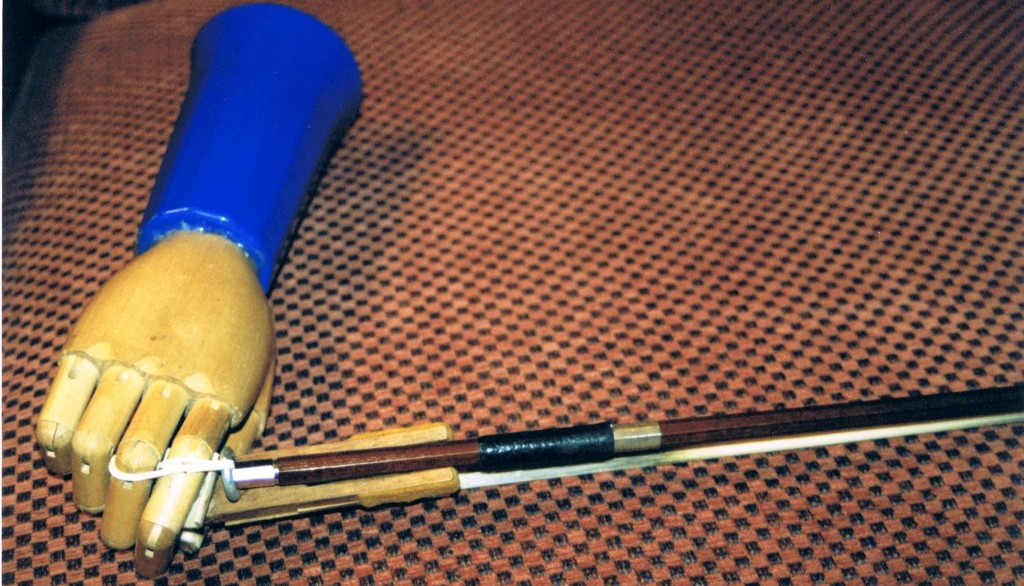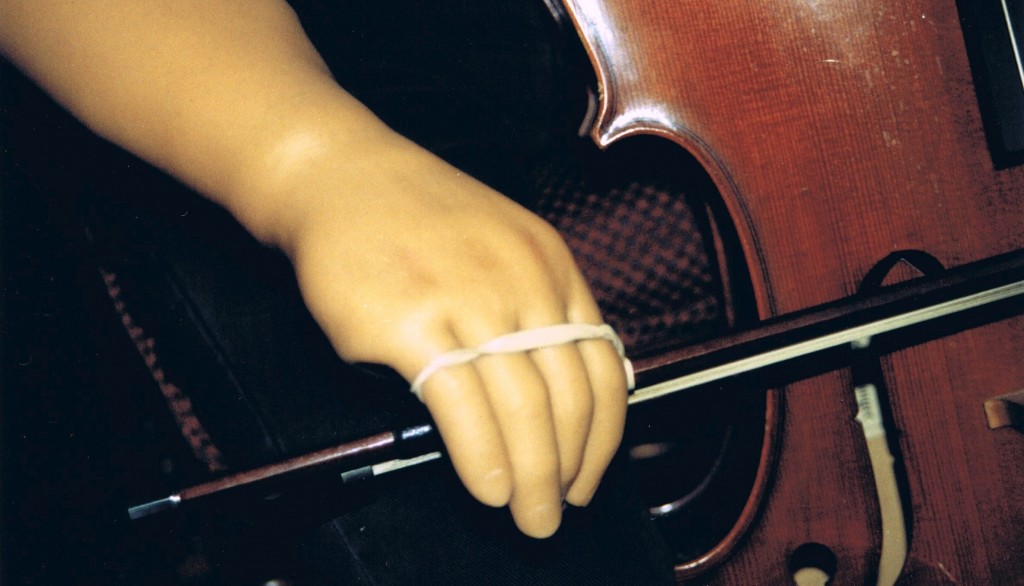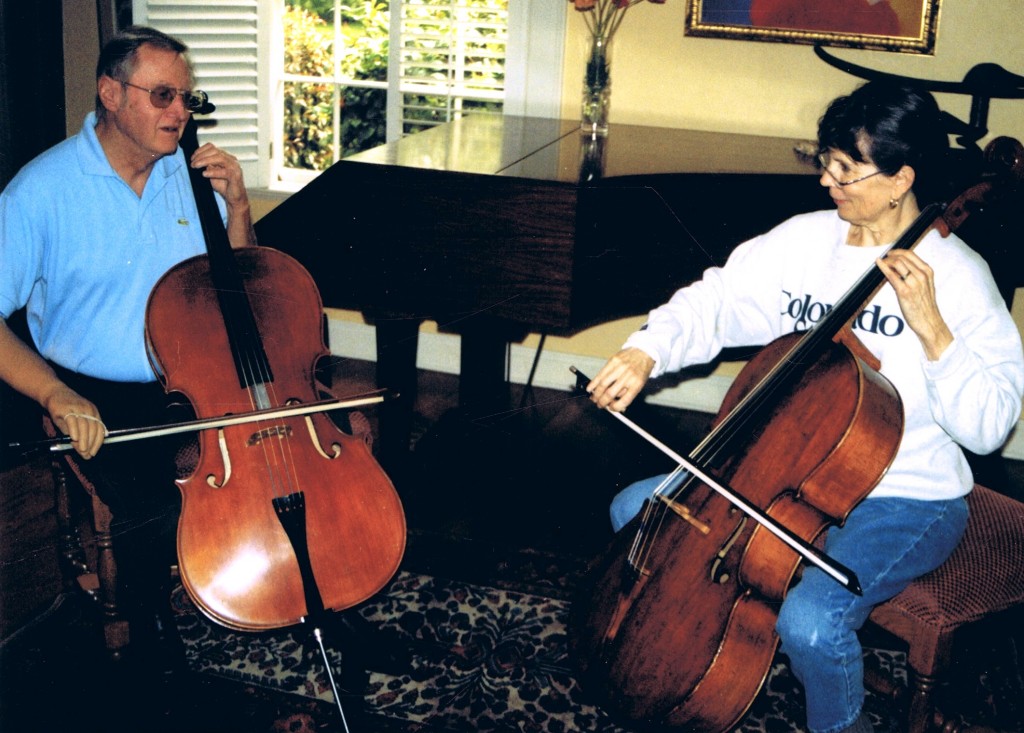by Nona Pyron
A few years ago I received a call from a man saying he wanted to learn to play the cello – that his dream for many years had been to play the cello and that now that he was retired he wanted to get started. George Cawelti was in his mid-sixties and while that was not an optimal time to begin cello playing, I knew from experience that simply the commitment – however little or much real accomplishment was achieved – could be a very fulfilling experience. However with George there was an even greater problem, one which I had never encountered, nor even imagined: George had no right hand.
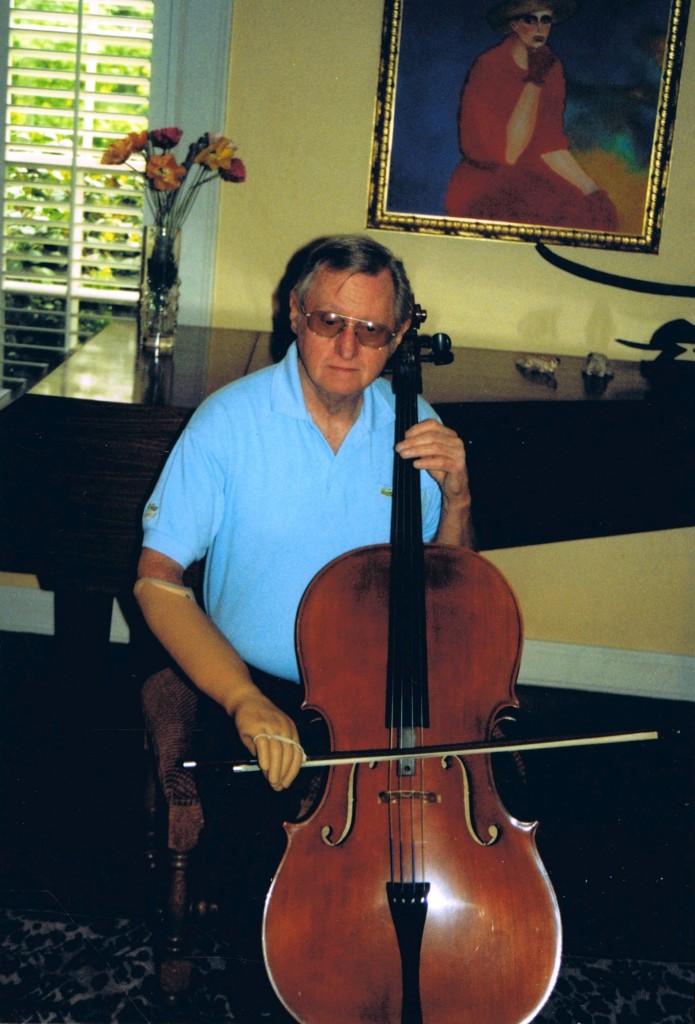 George’s right hand and arm midway between the wrist and elbow – had been blown off in a chemistry explosion when he was thirteen. I was dumbfounded. How could anyone expect to play the cello without a right hand? I didn’t know what to say. However, he was so determined that I finally agreed to see him, if for no other reason than to demonstrate to him in person why this was an impossible dream. I was unprepared for what happened.
George’s right hand and arm midway between the wrist and elbow – had been blown off in a chemistry explosion when he was thirteen. I was dumbfounded. How could anyone expect to play the cello without a right hand? I didn’t know what to say. However, he was so determined that I finally agreed to see him, if for no other reason than to demonstrate to him in person why this was an impossible dream. I was unprepared for what happened.
George appeared at the door and, after a few brief words of greeting, proceeded to unpack a cello which he had acquired some years earlier (a first step towards his dream). He was very deft, having learned through years of experience how to manage with just one hand, but I couldn’t avert my eyes from the stump that was the termination of his right arm some inches below the elbow. Then, to my amazement, he reached into a separate bag and pulled out a wooden hand – the kind with moveable fingers you see in art supply stores. The wrist of the hand had been glued to a blue Tupperware cup. Placing a washcloth over his stump, he pushed the cup on to his right arm and adjusted it carefully. Next he affixed the bow to an old-fashioned clothespin-like clamp which was attached to the palm of the wooden hand. He then sat down and proceeded to draw the bow across the strings (he had cleverly devised a post which was inserted into a protrusion extending from the fingerboard which served to keep the bow from sliding below the bridge).
I won’t pretend that the sound emanating from this effort was anything close to beautiful, but it was a sound that could be developed and that in itself was astonishing. I agreed to work with him. Surely someone with this much determination deserved an equal commitment on my part.
I should mention at this point that the same blast that took his right hand and arm also cost him the sight in his right eye and damaged the hearing in his right ear. In addition, he lost the last joint of his left thumb.
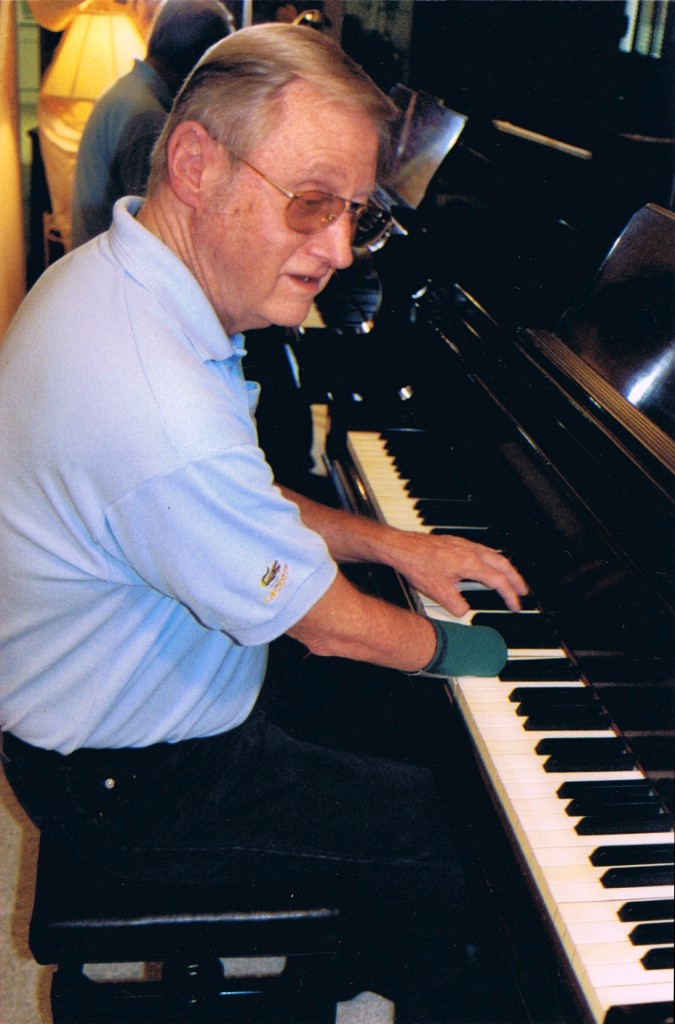
It is interesting how the musical spirit in a person will find its way out even in the most adverse circumstances. As he was packing up after one of his early lessons I left the room for a few minutes. Then from the music room I heard Beethoven’s Fur Elise being beautifully played on the piano. I had not heard anyone come in and couldn’t imagine who could be playing. I was astonished to find George seated at the piano playing most of the notes with his left hand and using the stump of his right arm like a mallet to play the tune in the right hand. He had mentioned in passing that he had studied piano for a while, but I hadn’t expected this. It made me realize that I was dealing with a very musical personality. Now it was my task to make it work for him on the cello.
Four years have gone by and in this time I have learned much from George. I have had to stretch my thinking in ways and directions I would never have considered. It was fascinating to discover how one could achieve bow strokes and articulations without a flexible wrist or fingers and even more interesting to see how much of what I teach my nonhandicapped students could apply, sometimes with minor alterations, to George. I saw early on that in order to know what to tell him to do, I had to experience it myself. “Give me your hand”, I would say jokingly to George, and George would obligingly remove the entire apparatus – Tupperware cup, wooden hand and attached bow – and give it to me. Placing my hand over the wooden hand, I would try to discover what was needed to achieve the stroke I was asking him to do. That way I could gain some understanding of what it felt like for him and then be able to describe to him what he had to do.
One thing became obvious quite early: for over half a century George had not really used his right arm except as a support for something he was doing with his left hand. The arm was stiff and unused to moving. To counteract this I had him take a dust doth and make wide dusting movements on the table -and then on the wall (“I have the cleanest table and wall in town”, he later joked). Eventually we were able to get a real prosthetic arm and hand for George. In some ways it was a great leap forward, but it also required a new learning curve. The first hurdle was to discover how to stabilize the bow within the prosthetic hand. George was very clever with rubber bands, and we spent much time finding the optimal combination – only to discard it a few weeks later for something that worked even better. Then there was the sheer weight of the new prosthesis and the question of how to compensate for that without stiffening the shoulder.
Another problem was how to open the elbow, which he tended to keep in a locked position. Many cellists and violinists have this problem, even without George’s handicap. But in George’s case, without the use of a moveable wrist, it tended to send the bow sliding in all directions. Over and over again I would ask George to give me his hand so that I could get the feel of it and discover what had to be done. Sometimes we even strapped the arm part to my arm so that I could be certain that I was duplicating his movements exactly. Little by little we found solutions. In the early stages George’s bow strokes were limited to the middle range of the bow. His right arm still balked at the big movements required for long bow strokes, and the problem of keeping the bow straight as he moved the arm out and the bow approached the tip even now continues to produce difficulties to some extent. But the difficulties are diminishing as time goes by. Bouncing bow (spiccato in all of its forms) proved less difficult. The hard part, which is true for any string player, was learning to ride the natural bounce of the bow and not interfere with it by one’s own determined efforts to control – something made even more difficult for George by the weight of the prosthesis.
 One problem still remained. The fact that his bow (because of the post which he relied on to keep his bow from sliding up and down the strings) was confined to the middle area of the strings, made it almost impossible for him to take advantage of the broad range of tonal colors available to most cellists, and thus of much of the expressive qualities he wanted in the music.
One problem still remained. The fact that his bow (because of the post which he relied on to keep his bow from sliding up and down the strings) was confined to the middle area of the strings, made it almost impossible for him to take advantage of the broad range of tonal colors available to most cellists, and thus of much of the expressive qualities he wanted in the music.
Then one day not too long ago we had an exciting breakthrough. I can’t remember exactly how it came about, but in the course of a lesson George suddenly discovered that he didn’t need the post to keep the bow from sliding down over the bridge. He went home determined to practice without the post. It took a lot of work, but with the skills he had accumulated he found he was able to do it. Now he is beginning to discover the wide spectrum of colors that are available to every cellist by using the whole tonal range between the fingerboard and bridge.
While the primary focus at the beginning was, understandably, on the right hand and arm, as time went on I found myself devoting more and more time in his lessons to his left hand, almost forgetting that this was a man with no right hand. His were the usual left-hand problems of flexibility and agility, relaxed shifts and proper placement of the thumb behind the hand in the lower positions and in thumb position (made even more difficult by the fact that he was missing the last joint on his left thumb), but he approached them with the same determination he had with everything else. By now George has worked his way through the Reinagle Studies, and the Somis and Schonebeck Sonatas, each one requiring a monumental effort on his part due to the loss of his right eye and the poor vision in his left (in essence, he has to memorize most of what he plays). He even decided to tackle, on his own, The Swan, and played it for me one day as a surprise. I had avoided such lyrical pieces because of the difficulties is presented in shaping long, sustained bows (still the hardest thing for him), but George was up to the challenge. He loved it so much (George loved every work he played!) that he was willing to put forth the effort and ended up with a very credible performance. His greatest love, however, has always been reserved for the Bach Suites. I don’t know for certain, but my suspicion is that he plays them nearly every day. This is quite a wonderful thing for a man with no right hand and who only began to play the cello in his mid-sixties. But, for me, the greatest satisfaction came recently when he walked in for his lesson and said, “I had the strangest sensation the other day when I was practicing: it felt like I had a real right hand…it felt like I was playing with my own hand.” When I heard that I knew we had accomplished a big part of his dream.

